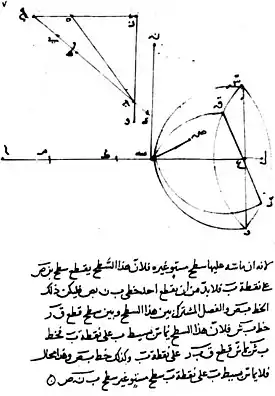Ibn Sahl (mathematician)
Ibn Sahl (full name: Abū Saʿd al-ʿAlāʾ ibn Sahl أبو سعد العلاء ابن سهل; c. 940–1000) was a Persian[2][3][4][5] mathematician and physicist of the Islamic Golden Age,[6] associated with the Buyid court of Baghdad. Nothing in his name allows us to glimpse his country of origin.[7]


He is known to have written an optical treatise around 984. The text of this treatise was reconstructed by Roshdi Rashed from two manuscripts (edited 1993).: Damascus, al-Ẓāhirīya MS 4871, 3 fols., and Tehran, Millī MS 867, 51 fols. The Tehran manuscript is much longer, but it is badly damaged, and the Damascus manuscript contains a section missing entirely from the Tehran manuscript. The Damascus manuscript has the title Fī al-'āla al-muḥriqa "On the burning instruments", the Tehran manuscript has a title added in a later hand Kitāb al-harrāqāt "The book of burners".
Ibn Sahl is the first Muslim scholar known to have studied Ptolemy's Optics, and as such an important precursor to the Book of Optics by Ibn Al-Haytham (Alhazen), written some thirty years later.[8] Ibn Sahl dealt with the optical properties of curved mirrors and lenses and has been described as the discoverer of the law of refraction (Snell's law).[9][10][11] Ibn Sahl uses this law to derive lens shapes that focus light with no geometric aberrations, known as anaclastic lenses. In the remaining parts of the treatise, Ibn Sahl dealt with parabolic mirrors, ellipsoidal mirrors, biconvex lenses, and techniques for drawing hyperbolic arcs.
Ibn Sahl designed convex lenses that focus lights rays that are parallel, which can cause an object to burn at a specific distance. A biconvex lens has the ability to focus at a specific point at an infinite distance. Ibn Sahl has made many contributions to optics, he also wrote an article about the celestial sphere. A constant ratio is the main focus point of his study, and it allows for a better understanding of refraction lenses. Ibn Sahl did an experiment where a piece of crystal was used to propagate a ray of light through the crystal which then refracts in the air.
References
- Kurt Bernardo Wolf, Geometric Optics on Phase Space, p. 9, Springer, 2004, ISBN 3-540-22039-9 online
- Enterprise of Science in Islam: New Perspectives - J. P. Hogendijk,A. I. Sabra "The first clear evidence we have of a correct understanding of Ptolemy's theory of refraction does not appear in the Arabic sources available to us until the second half of the tenth century, when the Persian mathematician al-Ala ibn Sahl was able to put Ptolemy's ideas to use in formulating entirely original geometrical arguments for the construction of burning instruments by means of refraction"
- http://www.iranicaonline.org/articles/optics,"There are a number of optical texts by authors with a Persian ethnicity or association. The earliest is Abu Saʿd al-ʿAlāʾ Ebn Sahl at the Persian Buyid court (945–1055), better known for his early conception of the “sine law of refraction” and burning mirrors (Rashed, 1990, pp. 464-68; 1993; 2005) than his work on optics proper (Sabra, 1989, pp. lix-lx; 1994)."
- https://ijhpm.org/index.php/IJHPM/article/download/111/62,"Exploiting the 10th-century Persian mathematician Ibn Sahl’s development on Ptolemy’s studies of refraction,48 he generalized the relationship between incident and refracted rays in a form that presaged Snell’s law."
- https://www.sciencelearn.org.nz/resources/1867-light-ideas-and-technology-timeline,"Persian scientist Ibn Sahl writes On burning mirrors and lenses, which sets out his understanding of how curved mirrors and lenses bend and focus light. He discovers a law of refraction mathematically equivalent to Snell’s law (1615)."
- Hogendijk, edited by Jan P.; Sabra, Abdelhamid I. (2003). The enterprise of science in Islam : new perspectives. Cambridge, Mass. ; London: MIT. p. 89. ISBN 0-262-19482-1.
{{cite book}}:|first1=has generic name (help) - "Nothing in his surname and given names, however, allows us to glimpse either his country of origin or his social and religious allegiance — unless a link may be established with another Ibn Sahl of the same period, who was an astrologer concerned with mathematics; for the time being, however, this connection has no historical value." Roshdi Rashed, Geometry and Dioptrics in Classical Islam, London (2005), p. 3.
- Rashed (1990:"Ibn al-Haytham was not the first to have effectively used Ptolemy's Optics, [...] al-Kindi was not the only significant figure in the history of Arabic optics before Ibn al-Haytham"
- "Roshdi Rashed, Historian of Greek and Arabic Mathematics". 2017: 12.
{{cite journal}}: Cite journal requires|journal=(help) - http://spie.org/etop/2007/etop07fundamentalsII.pdf," R. Rashed credited Ibn Sahl with discovering the law of refraction [23], usually called Snell’s law and also Snell and Descartes’ law."
- Smith, A. Mark (2015). From Sight to Light: The Passage from Ancient to Modern Optics. University of Chicago Press. p. 178. ISBN 9780226174761.
Sources
- Rashed, R. "A pioneer in anaclastics: Ibn Sahl on burning mirrors and lenses", Isis 81, pp. 464–491, 1990.
- Rashed, R., Géométrie et dioptrique au Xe siècle: Ibn Sahl, al-Quhi et Ibn al-Haytham. Paris: Les Belles Lettres, 1993
- Zghal, Mourad; et al. (2007). Nantel, Marc (ed.). "The first steps for learning optics: Ibn Sahl's, Al- Haytham's and Young's works on refraction as typical examples" (PDF). The Education and Training in Optics and Photonics Conference. Tenth International Topical Meeting on Education and Training in Optics and Photonics. International Commission for Optics. 9665: 3. Bibcode:2007SPIE.9665E..09Z. doi:10.1117/12.2207465. S2CID 13875045. Retrieved 20 June 2011.
- Berggren, Len (2007). "Ibn Sahl: Abū Saʿd al‐ʿAlāʾ ibn Sahl". In Thomas Hockey; et al. (eds.). The Biographical Encyclopedia of Astronomers. New York: Springer. p. 567. ISBN 978-0-387-31022-0. (PDF version)
- Selin, Helaine (1997). Encyclopaedia of the History of Science, Technology, and Medicine in Non-Western Cultures. Springer Science & Business Media. pp. 432–433. ISBN 978-07-92-34066-9.
- Sarmiş, İbrahım (1999). İBN SEHL - An article published in Turkish Encyclopedia of Islam. Vol. 20. Istanbul: TDV İslâm Ansiklopedisi. p. 312. ISBN 978-97-53-89447-0.
